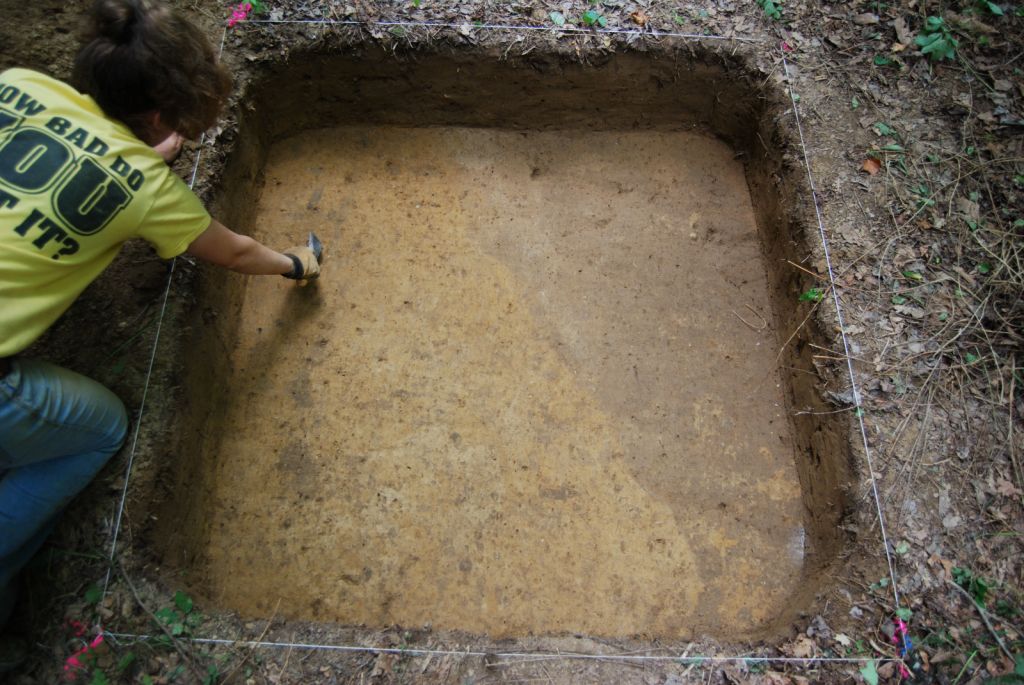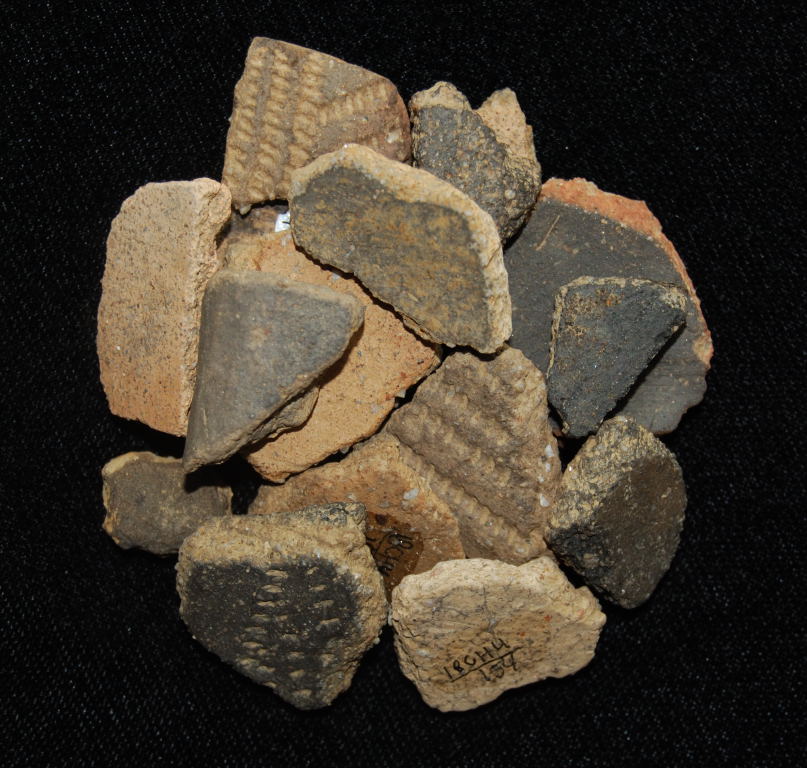Fair Fountain (18CH4)
Introduction
The Fair Fountain site (18CH4) is a well preserved 17th-century frontier settlement
located in close proximity to Zekiah Town (not to be confused with Zekiah Fort)
near La Plata in Charles County, Maryland. The site, which measures approximately
250 by 400 feet, is situated below a high terrace near Kerrick Run and Zekiah Swamp.
The soils in the study area consist of Beltsville Series on the terrace and Grosstown
Series along the gradual slopes (where 18CH4 is located).
The site is part of a 1,000-acre tract known as Fair Fountain first granted to Josias
Fendall in 1663. The site appears to have been occupied at about this time by an as-yet-unidentified
tenant (Fendall is known to have been living closer to the mouth of the Wicomico River).
In 1681, Fendall, a former proprietary governor who had been in conflict with Lord Baltimore
and the Maryland Council for years, was exiled from the colony. He sold Fair Fountain to
Henry Hawkins in 1683, although Hawkins lived at Johnsontown and not Fair Fountain. The
Fair Fountain site appears to have been abandoned ca. 1695.
While little documentary evidence survives about the site, the site's history of ownership,
dates of occupation, artifact assemblage, and location suggest that first Fendall and then
Hawkins may have had the tenant(s) on the property for the purpose of trading with the
local Indigenous population. Other documents indicate that residents of Zekiah Town would sell
deerskins to the colonists, using trails established along Zekiah Swamp to reach colonial
buyers at the Wicomico River's headwaters. The Fair Fountain site is the most northerly colonial site
along the Zekiah Swamp at this time.
Zekiah Town (not Zekiah Fort) was located somewhere in the vicinity. The same document
that describes people from Zekiah Town with skins to sell at the headwaters
of Wicomico River provides distances that place Zekiah Town in the vicinity of Kerrick
Run. Artifacts in the possession of a private individual and recovered from the vicinity
include dozens of Potomac Creek ceramics, numbers far higher than for most locations along
Zekiah Swamp. The majority of these ceramics were not recovered from the Fair Fountain site
but from nearby, although this second site has yet to be tested.
Regardless of the precise location of Zekiah Town, the archaeological evidence indicates
that the English tenant living at Fair Fountain was in close contact with both the people
living at Zekiah Town and probably later (after ca. 1680) with the Piscataways
living at Zekiah Fort. The Fair Fountain site represents a rare example of an English frontier
settlement that may have seen greater interaction between Indigenous people and a colonial household.
The abandonment of the site ca. 1695 roughly corresponds with the abandonment of Zekiah Fort.
 Troweling Test Unit 3, Fair Fountain Plantation (St. Mary's College of Maryland)
Troweling Test Unit 3, Fair Fountain Plantation (St. Mary's College of Maryland)
Archaeological Excavations
The Fair Fountain site (18CH4) was first identified in 1960 by R.B. Looker, Jr. and Carl
Manson. Looker and Manson's project was part of a survey of the Zekiah Swamp region and
focused on the identification of Native American archaeological sites. The two surveyors
described finding points, blades, scrapers, and European ceramics (but not Native
ceramics) at Fair Fountain although precisely where these materials were found on the greater
property remained unclear.
Between 1960 and 2009, the property owner's grandson surface-collected more than 2,000
artifacts from 18CH4 and its surrounding fields. The majority of the collection was gathered
south of a nearby cemetery not associated with the Fair Fountain site although it is considered
to be within the boundaries of 18CH4. The grandson, who kept some notes and photographs, described
the Fair Fountain site as the "Pipe Stem Field." In 2009, the collection of material in the
possession of the grandson was loaned to and cataloged by archaeologists from St. Mary's College
of Maryland. The collection consists of hundreds of artifacts, including lithics (mostly projectile
points), Native and European ceramics, 19th- and 20th-century ceramics, white and red clay tobacco
pipes, bottle glass, and other materials. The collection indicates a significant 17th-century
component at the "Pipe Stem Field."
In 2009 and 2010, St. Mary's College of Maryland under the direction of Julia A. King and Scott M.
Strickland undertook archaeological investigations in the vicinity of the "Pipe Stem Field."
In 2009, 216 shovel tests were excavated at intervals of 100 feet in a wooded area where the
grandson had pin-pointed Pipe Stem Field. Where artifacts were encountered, the shovel test interval
was reduced first to 50 and then to 25 feet. Soil from the shovel tests was screened through
¼-inch mesh. Stratigraphy at the site consisted of a plow zone overlying subsoil.
St. Mary's College returned to the site in 2010, excavating fourteen 5-by-5 foot test units in
an effort to increase artifact samples and to identify evidence of subsurface features. The units
were placed in areas where the shovel test pits had indicated concentrations of early colonial
domestic artifacts in association with Potomac Creek ceramics. Fill from the units was screened
through 1/4-inch mesh. A number of features were encountered during the testing, the majority of
which are unidentified and some of which included root molds and plow scars. At least one feature
may represent the edge of a cellar, borrow pit, or other cultural feature and a second feature
could represent traces of a structural post hole and mold, all dating to the site's 17th-century
occupation.
Other features appear to post-date the site's colonial occupation. Traces of a farm road, evidenced
by gravel encountered during excavation, were uncovered in one test unit while a possible post hole
and mold may suggest a 19th- or 20th-century farm gate. Plow scars were observed in at least five
units. The features were tested as part of these investigations.
 Potomac Creek ceramics recovered by a collector from the Fair Fountain
Plantation (St. Mary's College of Maryland)
Potomac Creek ceramics recovered by a collector from the Fair Fountain
Plantation (St. Mary's College of Maryland)
Artifacts
The collection in the possession of the property owner included 2,107 artifacts organized
by containers. The materials come from an area much greater in size than the Fair Fountain
site. Therefore, although the collection has been cataloged, the materials are not included
in the online database. A PDF of the paper catalog is, however, available on this website
in the section under catalogs.
Of the 216 shovel tests excavated in 2009 in the effort to relocate the Pipe Stem Field site,
145 are included in the site proper and are found in the online database. A total of 787
artifacts were recovered from the 145 shovel tests with an average of 3.6 artifacts per
shovel test; artifact recovery ranged between 0 and 129 artifacts. The shovel test data
revealed not only a 17th-century component but a long, pre-Contact archaeological history.
The 14 test units excavated in 2010 yielded 1,638 artifacts, all mirroring the materials
recovered from the shovel test pits along with several additional artifact types.
Artifacts recovered from the shovel tests and test units at Fair Fountain include lithics,
ceramics, tobacco pipes, bottle glass, nails, brick, and shell.
Lithics include tools, flakes, shatter, and fire-cracked rock. Diagnostic projectile points
include Clagett (3500-1000 BCE), Bare Island (2500-1600 BCE), Vernon (2500-1600 BCE),
Broadspear (post-2000 BCE), Calvert (1000 BCE-200 CE), Rossville (1000 BCE-200 CE),
and a single triangular point. Lithics also include fragments of European flint,
one of which is possibly a strike-a-light. A second flint or chalcedony fragment was
found in association with Native ceramics.
Ceramics include Potomac Creek wares, including plain and cord-marked varieties, tin-glazed
earthenwares, lead-glazed coarse earthenwares, Buckley-like earthenwares, Rhenish and
English brown stonewares, and white salt-glazed stonewares. Ceramics dating to the later
colonial and post-colonial periods include creamware, pearlware, yellowware, whiteware,
North American gray salt-glazed stoneware, and porcelain.
A fragment of what may be colonoware, or a hand-built ceramic made in European form, was
also recovered from the Fair Fountain site and appears to derive from a rim. The fragment
came from plow zone and is small in size. The fragment is somewhat irregular for Potomac
Creek with significantly less sand-/grit-temper than the other Potomac Creek fragments.
The fragment has an overall smoother fabric and the rim appears to be more pointed than
rounded.
Both white and red clay tobacco pipe fragments were recovered from the Fair Fountain site.
Thirty-two white clay tobacco pipe stem fragments yielded a Binford date of 1665 and a
Harrington histogram date of 1660-1690. No complete pipe bowls were recovered although
one rouletted bowl fragment was. Red clay tobacco pipe fragments include both those made
in molds (presumably by colonists) and those built by hand (presumably by Indigenous people).
Two mold-made pipes, each with a bore diameter of 6/64ths-inch, are marked "WD." The
"WD" mark also appears on red pipes recovered from other Potomac valley sites,
including St. John's (18ST1-23), Smith's Ordinary (18ST1-13), and Notley Hall (18ST74)
in St. Mary's County, Maryland, the Fendall/Digges site (18CH805) in Charles County,
Maryland, and the John Washington site (44WM204) in Westmoreland County, Virginia.
The red WD pipes recovered from these sites were all found in contexts dating ca.
1660-1680s. The initials may be those of William Digges, a son-in-law of Charles
Calvert, who lived at Notley Hall and then the Fendall/Digges site.
Seventy-three glass fragments were recovered, 14 of which are modern in date. Colonial
bottle glass fragments included round and case (flat) bottle fragments.
Architectural artifacts include brick, daub, plaster, nails, and window glass. Brick represents
the largest category of architectural material, with two handmade brick bats recovered.
One bat measures 2 3/8 by 4 1/4 inches (473.0 g) and the second measures 2 1/4 inches (268.3 g).
The majority of these fragments, however, especially those identified as daub/brick,
average less than ½-inch in size. Only two small fragments of plaster, which would
have been used to provide for smooth walls and brighter rooms, were found; interestingly,
these two plaster fragments were recovered from shovel tests and not from the larger test
units. Wrought and unidentified square nails and other nail fragments too corroded to identify dominate
the assemblage although two wire nails were also recovered. The wire and perhaps some
of the square nails may be associated with a large 19th-century barn located in the
western portion of the project area.
Only one possible bone fragment and three oyster shell fragments were recorded. While
this low density is not unexpected given both the plowed contexts and the acidic nature
of the soils, it is striking when compared with the animal bone counts recovered from
the Zekiah Fort site.
One especially interesting find includes a single fragment of copper scrap.
The distribution of artifacts recovered from shovel tests reveal an intriguing pattern:
Potomac Creek ceramics are distributed directly adjacent to but not overlapping with
a concentration of colonial artifacts, suggesting some sort of association. The
concentration of colonial artifacts includes case bottle, white and red clay
tobacco pipe fragments, European flint, and English brown stoneware fragments.
The close association but obvious segregation of the two sets of artifacts is
striking. Whether this delineation represents spheres of interaction is unknown.
References
Strickland, Scott M., and Julia A. King. 2011. An Archaeological
Survey of the Charleston Property: Josias Fendall's Dwelling Plantation. St.
Mary's City: St. Mary's College of Maryland.
What You Need To Know To Use This Collection
Only materials from the 2009 and 2010 fieldwork are found in the database. Materials found
in the property owner's collections are catalogued in a separate PDF file found on this
web site.
Further Information About the Collection
The Fair Fountain site collection is privately owned and not accessible for study.
To Download Data
Data and a variety of other resources from this site are available for download. To download data,
please go to the Downloads page.